Yes, you can find the best number of clusters using Elbow method, but I found it troublesome to find the value of clusters from elbow graph using script. You can observe the elbow graph and find the elbow point yourself, but it was lot of work finding it from script.
So another option is to use Silhouette Method to find it. The result from Silhouette completely comply with result from Elbow method in R.
Here`s what I did.
#Dataset for Clustering
n = 150
g = 6
set.seed(g)
d <- data.frame(x = unlist(lapply(1:g, function(i) rnorm(n/g, runif(1)*i^2))),
y = unlist(lapply(1:g, function(i) rnorm(n/g, runif(1)*i^2))))
mydata<-d
#Plot 3X2 plots
attach(mtcars)
par(mfrow=c(3,2))
#Plot the original dataset
plot(mydata$x,mydata$y,main="Original Dataset")
#Scree plot to deterine the number of clusters
wss <- (nrow(mydata)-1)*sum(apply(mydata,2,var))
for (i in 2:15) {
wss[i] <- sum(kmeans(mydata,centers=i)$withinss)
}
plot(1:15, wss, type="b", xlab="Number of Clusters",ylab="Within groups sum of squares")
# Ward Hierarchical Clustering
d <- dist(mydata, method = "euclidean") # distance matrix
fit <- hclust(d, method="ward")
plot(fit) # display dendogram
groups <- cutree(fit, k=5) # cut tree into 5 clusters
# draw dendogram with red borders around the 5 clusters
rect.hclust(fit, k=5, border="red")
#Silhouette analysis for determining the number of clusters
library(fpc)
asw <- numeric(20)
for (k in 2:20)
asw[[k]] <- pam(mydata, k) $ silinfo $ avg.width
k.best <- which.max(asw)
cat("silhouette-optimal number of clusters:", k.best, "
")
plot(pam(d, k.best))
# K-Means Cluster Analysis
fit <- kmeans(mydata,k.best)
mydata
# get cluster means
aggregate(mydata,by=list(fit$cluster),FUN=mean)
# append cluster assignment
mydata <- data.frame(mydata, clusterid=fit$cluster)
plot(mydata$x,mydata$y, col = fit$cluster, main="K-means Clustering results")
Hope it helps!!



